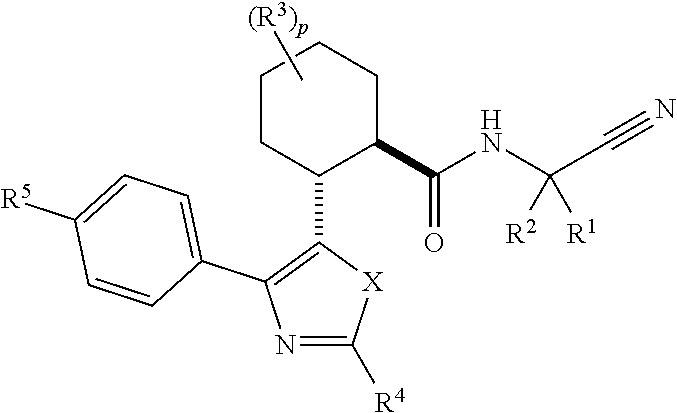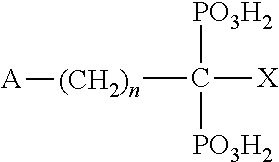Cathepsin cysteine protease inhibitors
- Summary
- Abstract
- Description
- Claims
- Application Information
AI Technical Summary
Benefits of technology
Problems solved by technology
Method used
Image
Examples
example 1
[0223]
(1R,2R)—N-(1-Cyanocyclopropyl)-2-(2-(3,4-difluorophenyl)-4-(4-(1,1-dioxidothiomorpholino)phenyl)oxazol-5-yl)cyclohexanecarboxamide (Compound 1)
Step A: (1R,2R)-Methyl 2-(2-(4-bromophenyl)acetyl)cyclohexanecarboxylate
[0224]Preparation of 1 M CuCN.2LiCl: A mixture of CuCN (1.792 g, 20 mmol) and LiCl (1.696 g, 40 mmol) was dried under vacuum at 140° C. for 5 h. After cooling the mixture down to rt, 20 mL THF was added and stirred at rt overnight to give a light green solution.
[0225]To a solution of CuCN.2LiCl (1 M, 12.82 mL) in THF at −25° C. was added a solution of 4-bromobenzylzinc bromide (0.5 M, 25.6 mL) in THF dropwise and stirred for 15 min. A solution of (1R,2R)-methyl 2-(chlorocarbonyl)cyclohexanecarboxylate (2.187 g, 10.69 mmol) in THF (7 mL) was added dropwise and the resulting mixture was stirred for 5 min at −25° C., for 15 min at 0° C. and 4 h at rt. Partition the reaction mixture between EtOAc and aqueous NH4OH-aqueous saturated NH4Cl (1:2 v / v, 200 mL). Aqueous layer...
example 2
[0233]
(1R,2R)—N-(1-Cyanocyclopropyl)-5,5-difluoro-2-(4-(4-(morpholine-4-carbonyl)phenyl)-2-(perfluoroethyl)oxazol-5-yl)cyclohexanecarboxamide (Compound 2)
Step A: tert-Butyl 4-(2-((1R,2R)-4,4-diflouro-2-methoxycarbonyl)cyclohexyl)-2-oxoethyl)benzoate
[0234]This compound was prepared from (1R,2R)-4,4-difluoro-2-(methoxycarbonyl)cyclohexanecarboxylic acid (INTERMEDIATE 3) through its acid chloride and (4-(tert-Butoxycarbonyl)benzyl)zinc(II) bromide (INTERMEDIATE 2) using a similar procedure as described in Step A of Example 1.
Step B: 4-(2-((1R,2R)-4,4-Difluoro-2-(methylcarbonyl)cyclohexyl)-2-oxoethyl)benzoic acid
[0235]To a solution of tert-butyl 4-(2-((1R,2R)-4,4-difluoro-2-(methoxycarbonyl)cyclohexyl)-2-oxoethyl)benzoate (845 mg, 2.132 mmol) in dichloromethane (4 mL) was added TFA (5 mL). After stirring at 23° C. for 30 min, the reaction mixture was diluted with EtOAc, washed with water (2×) and brine (1×), dried over Na2SO4 and concentrated to give a white solid which was used without...
example 3
[0244]
(1R,2R)—N-(1-Cyanocyclopropyl)-2-(4-(4-(1,1-dioxidothiomorpholino)phenyl)-2-(perfluoroethyl)oxazol-5-yl)cyclohexanecarboxamide (Compound 3)
Step A: (1R,2R)-Methyl 2-(4-(4-bromophenyl)-2-(perfluoroethyl)oxazol-5-yl)cyclohexanecarboxylate
[0245]To a solution of (1R,2R)-methyl 2-(2-amino-2-(4-bromophenyl)acetyl)cyclohexanecarboxylate hydrochloride from Step D Example 1 (250 mg, 0.64 mmol) and Et3N (259 mg, 2.56 mmol) in dichloromethane (3 mL) was added a solution of 2,2,3,3,3-pentafluoropropanoic anhydride (397 mg, 1.28 mmol) in dichloromethane (3 mL) dropwise and stirred for 15 min. The reaction mixture was partitioned between dichloromethane and saturated aqueous NaHCO3 solution. Aqueous layer was extracted with dichloromethane (3×). Combined organic solutions were dried over Na2SO4 and concentrated and purified by reverse phase HPLC (Sunfire C18 30×150 mm column; 30 to 95% MeCN in water. 0.1% TFA modifier for MeCN and water) to give desired product as a viscous yellow liquid (60...
PUM
 Login to View More
Login to View More Abstract
Description
Claims
Application Information
 Login to View More
Login to View More - R&D
- Intellectual Property
- Life Sciences
- Materials
- Tech Scout
- Unparalleled Data Quality
- Higher Quality Content
- 60% Fewer Hallucinations
Browse by: Latest US Patents, China's latest patents, Technical Efficacy Thesaurus, Application Domain, Technology Topic, Popular Technical Reports.
© 2025 PatSnap. All rights reserved.Legal|Privacy policy|Modern Slavery Act Transparency Statement|Sitemap|About US| Contact US: help@patsnap.com



